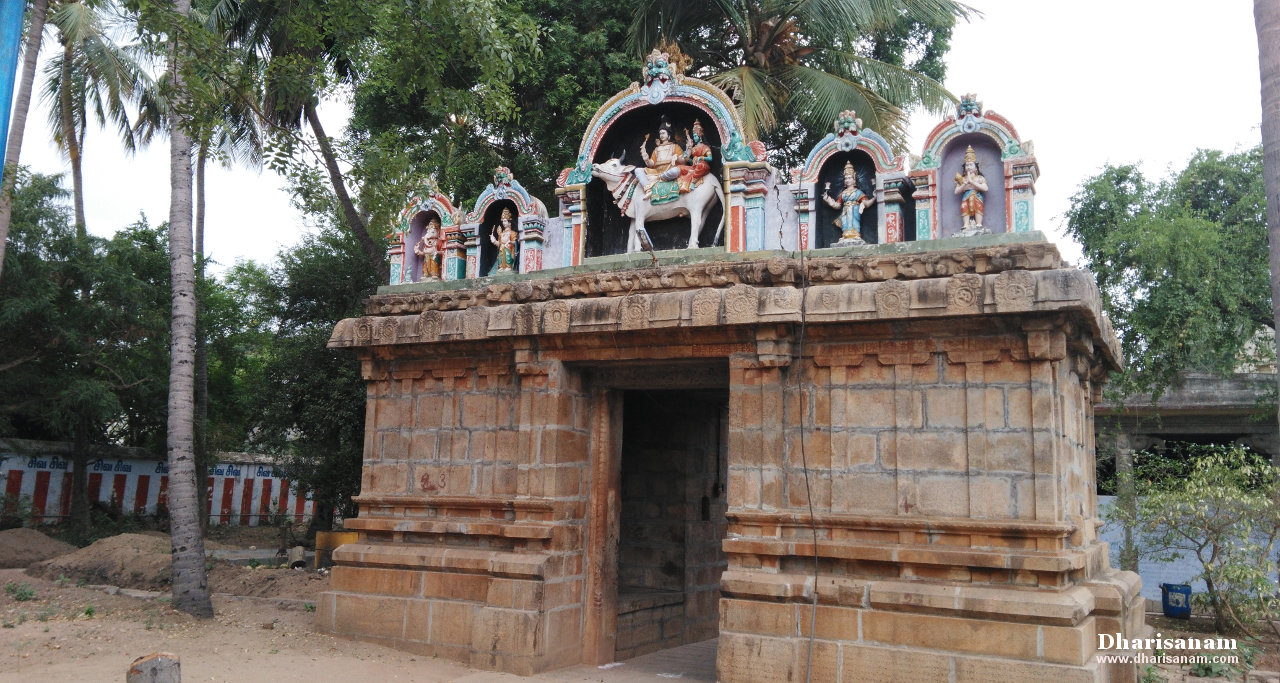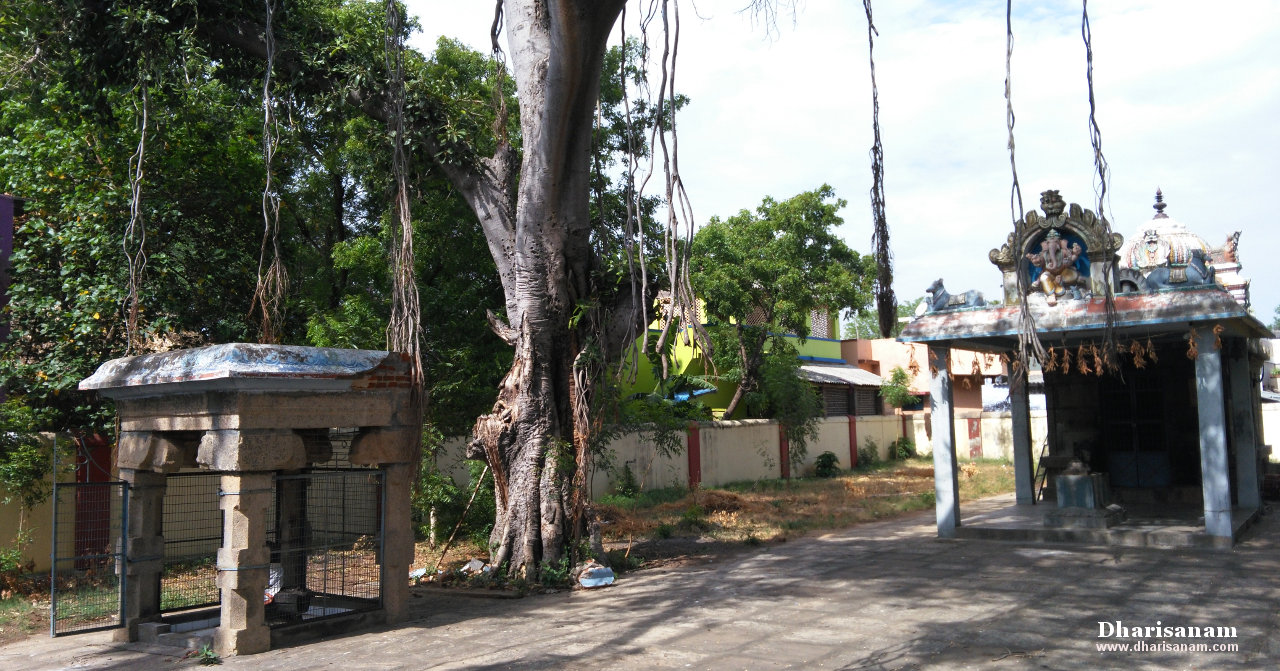Visited on: 24th August, 2018.
Location
Anbil Alandurai (Keezh Anbil) is located at a distance of about 30 kms from Trichy and 8 kms away from Lalgudi on the Trichy to Lalgudi route.
Other Devara Paadal Petra Shiva Sthalams near this place are –
Thirumanthurai, Thirukkanur, Mela Thirukkattuppalli, Thiruppatrurai, Perumpuliyur, Thiru Mazhapadi, Thiru Pazhuvoor, Thiruvaiyaru, Thiru Neithanam, Kandiyur, Thiru Chotruthurai, Thiru Vedhikudi, Thiruppoonthuruthi, Thiruvaalampozhil, Thiruvanaikkaval, Trichy Malaikkottai, Karkudi, Mukkeecharam, Erumbiyur and Nedungalam.
General Information
| Moolavar | Sri Sathiyavakeeswarar, Sri Alanthuraiyar, Sri Brahmapureeswarar |
| Ambal | Sri Soundhara Nayagi |
| Theertham (Holy water) | Chandra Theertham |
| Sthala Vriksham (Sacred Tree) | Banyan tree |
| Pathigam (Hymn) rendered by | Saint Thirugnanasambanthar, Saint Thirunavukarasar (Appar) |
- This is one of the 276 Devara Paadal Petra Shiva Sthalams and 57th Shiva Sthalam on the northern bank of the river Cauvery in Chozha Nadu (Vadakarai).
- Lord Shiva in this temple is a Swayambumurthi (self-manifested).
- This east facing temple has two corridors and its main tower (Rajagopuram) has 5-tiers.
- The last consecration ceremony (Maha Kumbabishekam) took place on 09.06.2004.
History of the Temple
Anbilanthurai is a combination of the name of this village “Anbil” and the name of this temple “Alanthurai”.
This place is located on the northern bank of the river Coleroon (Kollidam), a tributary of the river Cauvery.
There are some stone inscriptions in the temple which date back to the periods of Cholas and the Hoysalas.
It is believed that this temple was originally a Maada Kovil (a temple built on a raised platform). It was later rebuilt by the Chola King Parantakan-I without the elevated platform.
This temple is under the administrative control of the Hindu Religious and Charitable Endowments Department of Government of Tamil Nadu (HR&CE).


Legend
It is believed that Chola King Paranthakan had brought some Jaimini Brahmins of Sama Veda to this village in order to recite “Saamaveda parayanam” in front of the Vinayakar. It is because of this that the idol of “Sevi Saitha Vinayakar” is also named as “Sama Veda Vinayakar”. This Vinayakar is also praised as “Sri Samakanam Ketta Vinayakar”.
According to legend, Saint Thirugnanasambanthar was passing through this place and wanted to visit this temple. However, Lord Shiva was keen to test the saint’s devotion and caused heavy floods in the river Cauvery. Since the saint was unable to reach this temple, he sang his song from the other side of the river. The interesting thing to note here that Lord Vinayakar’s reaction to the saint’s song. He bent down to a half-sitting posture, turned his ears to the direction of the sound and enjoyed the hymns with a smile. Hence this Lord Vinayakar is known as “Sri Sevi Saitha Vinayakar” (“Sevi” means ear, “Saitha” means leaning in Tamil). This idol is a masterpiece of this temple’s architecture. The idol of Sri Sevi Saitha Vinayakar can be seen near the Vinayakar shrine in the corridor. This Vinayakar is also known as “Ilaya Pillaiyar”, meaning young Pillaiyar.
Another legend associated with this temple is that Lord Brahma worshiped Lord Shiva here. Hence, Lord Shiva is praised here as “Sri Brahmapureeswarar.
It is believed that Saint Vageesar also worshiped Lord Shiva here. Hence, Lord Shiva here also praised as “Sri Satyavageeswarar”.
It is believed that Goddess Parvathy, Iyyanar and the Navagraham have worshiped Lord Shiva here.
Deities in the temple
Other than the shrines of Lord Shiva and Goddess Parvathy, shrines and idols of Vinayakar, Murugan with his consorts, Lingothbavar (Annamalaiyar), Pitchandavar, Nalvar with Sekkizhar, Kasi Viswanathar with Visalakshi, Suryan, Chandran, Bairavar, Saneeswarar, Chandikeswarar and Navagraham can be seen in the main hall and the corridors.
In the “koshtam” (place surrounding the sanctum sanctorum), idols of Narthana Vinayakar, Dakshinamurthy, Mahavishnu, Brahma and Durgai can be seen.








Salient Features
There are beautiful reliefs of certain gods and goddesses on the sanctum wall depicting their worship of Lord Shiva. These includes - Lord Mahavishnu-Suryan, Ankarakan-Brahma, Goddess Parvathy and Adhisheshan.
In the Navagraham, all the other idols are facing Lord Suryan.
There are numerous beautiful reliefs carved in the pillars of this temple. Some of them are - lord Murugan worshiping Lord Shiva; a snake coiled around a pillar; two snakes joined in between a Shiva lingam; a snake swallowing an animal; a rishi with the body of an animal; a lion holding a deer and an elephant’s trunk being held by another animal.
The sanctum sanctorum is in the form of semi-circular tank (“akazhi” in Tamil).
This temple “Sthala Viruksham” (Banyan tree) can be seen next to this temple in a separate Vinayakar temple.






Greatness of this temple
Those suffering from hearing impairment can pray to Lord Vinayakar in this temple for relief.
Important Festivals
Some of the important festivals celebrated in this temple are –
Aani Thirumanjanam in the Tamil month of Aani (June-July),
Aadi Pooram in the Tamil month of Aadi (July-Aug),
Vinayakar Chaturthi in the Tamil month of Aavani (Aug-Sept),
Navarathri in the Tamil month of Purattasi (Sept-Oct),
Skanda Shashti and Annabishekam in the Tamil month of Aippasi (Oct–Nov),
Thiru Karthikai in the Tamil month of Karthikai (Nov-Dec),
Thiruvadhirai in the Tamil month of Markazhi (Dec-Jan),
Makara Sankranthi in the Tamil month of Thai (Jan-Feb),
Shivrathri in the Tamil month of Masi (Feb-Mar) and
Panguni Uthiram in the Tamil month of Panguni (Mar-Apr).
Pradosham is also observed regularly.
Temple Timings
From 07:00 AM to 12:00 Noon and from 04:30 PM to 08:30 PM.
Temple Address
Sri Sathyavageeswarar temple,
Anbil Alanthurai Post,
Lalgudi Taluk,
Trichy District,
Tamil Nadu – 621 702.
Tele: +91 - 431-2544927.
This temple’s priest Sri Shanmugasundara Gurukkal can be contacted at +91 - 99657 39750.








Pathigam (Hymn) with English transliteration and Tamil meaning.
Saint Thirugnanasambanthar visited this temple and sang this Pathigam.
Devotees visiting this temple should make it a practice to recite this Pathigam.
Pathigam No.1.033.
கணைநீடெரி மாலர வம்வரை வில்லா
இணையாஎயில் மூன்றும் எரித்த இறைவர்
பிணைமாமயி லுங்குயில் சேர்மட அன்னம்
அணையும்பொழில் அன்பிலா லந்துறை யாரே.
“Kaṇainīṭeri mālara vamvarai villā
iṇaiyā'eyil mūṉtṟum eriththa iṟaivar
piṇaimāmayi luṅkuyil sērmada aṉṉam
aṇaiyumpozhil aṉpilā lanthuṟai yārē”.
நீண்டு எரிகின்ற தீயையும் திருமாலையும் அம்பாகக் கொண்டு பூட்டி வாசுகி
என்னும் பாம்பை நாணாகக் கட்டிய மேருமலையை வில்லாக வளைத்து
முப்புரங்களையும் எரித்த இறைவர், தத்தம் பெடைகளோடுகூடிய பெரிய
மயில்களும், குயில்களும் சேர்ந்து வாழும் அன்னங்களும் உறையும் பொழில்
சூழ்ந்த அன்பிலாலந்துறையார் ஆவார்.
சடையார்சது ரன்முதி ராமதி சூடி
விடையார் கொடியொன்றுடை யெந்தை விமலன்
கிடையாரொலி ஓத்தர வத்திசை கிள்ளை
அடையார்பொழில் அன்பிலா லந்துறை யாரே.
“Saṭaiyārsathu raṉmuthi rāmathi chūṭi
viṭaiyār koṭiyoṉtṟuṭai yenthai vimalaṉ
kiṭaiyāroli ōththara vaththisai kiḷḷai
aṭaiyārpozhil aṉpilā lanthuṟai yārē”.
சடைமுடிகளோடு கூடிய சதுரப்பாடு உடையவராய் இளம்பிறையை
முடிமிசைச் சூடி இடபக்கொடி ஒன்றை உடைய எந்தையாராகிய விமலர்,
வேதம் பயிலும் இளஞ்சிறார்கள் கூடியிருந்து ஓதும் வேத ஒலியைக் கேட்டு
அவ்வோசையாலேயே அவற்றை இசைக்கின்ற கிளிகள் அடைதல்
பொருந்திய சோலைகளால் சூழப்பட்ட அன்பிலாலந்துறை இறைவராவார்.
ஊரும்மர வஞ்சடை மேலுற வைத்துப்
பாரும்பலி கொண்டொலி பாடும் பரமர்
நீருண்கய லும்வயல் வாளை வராலோ
டாரும்புனல் அன்பிலா லந்துறை யாரே.
“Ūrum'mara vañchaṭai mēluṟa vaiththup
pārumpali koṇṭoli pāṭum paramar
nīruṇkaya lumvayal vāḷai varālō
ṭārumpuṉal aṉpilā lanthuṟai yārē”.
ஊர்ந்து செல்லும் பாம்பைச் சடைமுடிமேல் பொருந்த அணிந்து உலகம்
முழுதும் சென்று பலியேற்று, இசை பாடி மகிழும் பரமராகிய பெருமானார்,
நீரின்வழி உணவுண்ணும் கயல் மீன்களை வயல்களிடத்துள்ள வாளை வரால்
ஆகிய மீன்கள் உண்ணும் புனல்வளம் மிக்க அன்பிலாலந்துறையாராவார்.
பிறையும்மர வும்முற வைத்த முடிமேல்
நறையுண்டெழு வன்னியு மன்னு சடையார்
மறையும்பல வேதிய ரோத ஒலிசென்
றறையும்புனல் அன்பிலா லந்துறை யாரே.
“Piṟaiyum'mara vum'muṟa vaiththa mudimēl
naṟaiyuṇṭezhu vaṉṉiyu maṉṉu saṭaiyār
maṟaiyumpala vēthiya rōtha oliseṉ
tṟaṟaiyumpuṉal aṉpilā lanthuṟai yārē”.
பிறைமதி, பாம்பு ஆகியவற்றைப் பகை நீக்கி ஒருங்கே பொருந்த வைத்த
முடிமீது, நறுமணத்துடன் தோன்றும் வன்னித் தளிர்களும் மன்னிய
சடையினர், வேதியர் பலர் வேதங்களை ஓத அவ்வொலி பல இடங்களிலும்
ஒலிக்கும் நீர்வளம்மிக்க அன்பிலாலந்துறை இறைவராவார்.
நீடும்புனற் கங்கையுந் தங்க முடிமேல்
கூடும்மலை யாளொரு பாகம் அமர்ந்தார்
மாடும்முழ வம்மதி ரம்மட மாதர்
ஆடும்பதி அன்பிலா லந்துறை யாரே.
“Nīṭumpuṉaṟ gaṅkgaiyun thaṅka mudimēl
kūṭum'malai yāḷoru pākam amarnthār
māṭum'muzha vam'mathi ram'maṭa māthar
āṭumpathi aṉpilā lanthuṟai yārē”.
முடிமேல் பெருகிவரும் நீரை உடைய கங்கை நதியையும் தங்குமாறு
அணிந்து, ஒருபாகமாகத் தம்மைத் தழுவிய மலைமகளைக் கொண்டுள்ள
பெருமானார், பல இடங்களிலும் முழவுகள் ஒலிக்க, இளம் பெண்கள் பலர்
நடனங்கள் புரியும் அன்பிலாலந்துறை இறைவராவார்.
நீறார்திரு மேனிய ரூனமி லார்பால்
ஊறார் சுவையாகிய உம்பர் பெருமான்
வேறாரகி லும்மிகு சந்தனம் உந்தி
ஆறார்வயல் அன்பிலா லந்துறை யாரே.
“Nīṟārthiru mēṉiya rūṉami lārpāl
ūṟār suvaiyākiya umpar perumāṉ
vēṟāraki lum'miku santhaṉam unthi
āṟārvayal aṉpilā lanthuṟai yārē”.
திருநீறு அணிந்த திருமேனியரும், குற்றம் அற்றவர்களின் உள்ளங்களில்
பொருந்திய சுவையாக இனிப்பவருமாகிய தேவர் தலைவர், வேறாகப்
பெயர்ந்து வரும் அகில் மரங்களையும் உயர்ந்த சந்தன மரங்களையும்
அடித்துவரும் ஆற்று நீர் பாயும் வயல்களை உடைய அன்பிலாலந்துறை
இறைவர் ஆவார்.
செடியார்தலை யிற்பலி கொண்டினி துண்ட
படியார்பர மன்பர மேட்டிதன் சீரைக்
கடியார்மல ரும்புனல் தூவிநின் றேத்தும்
அடியார்தொழும் அன்பிலா லந்துறை யாரே.
“Seṭiyārthalai yiṟpali koṇṭiṉi thuṇṭa
paṭiyārpara maṉpara mēṭṭithaṉ sīraik
kaṭiyārmala rumpuṉal thūviniṉ tṟēththum
aṭiyārthozhum aṉpilā lanthuṟai yārē”.
முடை நாற்றமுடைய தலையோட்டில் பலியேற்று அதனை இனிதாக
உண்டருளும் தன்மையினைக் கொண்ட பரமனாகிய பரம்பொருள்,
மணம் பொருந்திய மலர்களையும் நீரையும் தூவி நின்று தன்புகழைத்
துதிக்கும் அடியவர்களால் தொழப்படும் அன்பிலாலந்துறை
இறைவராவார்.
விடத்தார் திகழும்மிட றன்நட மாடி
படத்தாரர வம்விர வுஞ்சடை ஆதி
கொடித்தேரிலங் கைக்குலக் கோன்வரை யார
அடர்த்தாரருள் அன்பிலா லந்துறை யாரே.
“Viṭaththār thikazhum'miṭa ṟaṉnaṭa māṭi
paṭaththārara vamvira vuñchaṭai āthi
koṭiththērilaṅ kaikkulak kōṉvarai yāra
aṭarththāraruḷ aṉpilā lanthuṟai yārē”.
ஆலகால விடக்கறை விளங்கும் கரிய கண்டத்தினரும், நடனமாடியும்,
படத்தோடு கூடிய அரவம் விரவும் சடையினை உடைய முதற்கடவுளும்,
கொடித் தேரைக் கொண்ட இலங்கையர் குலத் தலைவனாகிய
இராவணனைமலையின்கீழ் அகப்படுத்தி அடர்த்தவரும் ஆகிய சிவபிரான்,
அன்பர்கள் அருள் பெறுதற்குரிய இடமாக விளங்கும் அன்பில்
ஆலந்துறை என்னும் தலத்தில் எழுந்தருளியுள்ளார்.
வணங்கிம்மலர் மேலய னும்நெடு மாலும்
பிணங்கியறி கின்றிலர் மற்றும் பெருமை
சுணங்குமுகத் தம்முலை யாளொரு பாகம்
அணங்குந்திக ழன்பிலா லந்துறை யாரே.
“Vaṇaṅkim'malar mēlaya ṉumneṭu mālum
piṇaṅkiyaṟi kiṉtṟilar matṟum perumai
suṇaṅkumukath tham'mulai yāḷoru pākam
aṇaṅkunthika zhaṉpilā lanthuṟai yārē”.
தாமரை மலர்மேல் விளங்கும் அயனும் திருமாலும், சிவபிரானின்
பெருமையை வணங்கி அறியாது, தம்முட் பிணங்கித் தேடி
அறியாதவராயினர். அப்பெருமான், சுணங்கு பொருந்திய முகப்பினை
உடைய அழகிய தனத்தவளாய உமையம்மையை ஒருபாகத்தே
அணங்காகக் கொண்டுள்ள அன்பிலாலந்துறை இறைவராவார்.
தறியார்துகில் போர்த்துழல் வார்சமண் கையர்
நெறியாஉண ராநிலை கேடினர் நித்தல்
வெறியார்மலர் கொண்டடி வீழும் அவரை
அறிவாரவர் அன்பிலா லந்துறை யாரே.
“Thaṟiyārthukil pōrththuzhal vārsamaṇ kaiyar
neṟiyā'uṇa rānilai kēṭiṉar niththal
veṟiyārmalar koṇṭaṭi vīzhum avarai
aṟivāravar aṉpilā lanthuṟai yārē”.
தறிபோல ஆடையின்றி உள்ள சமணர்கள், நெய்த ஆடையினை உடலில்
போர்த்து உழலும் புத்தர்கள், பரம்பொருளை முறையாக உணராததோடு,
நிலையான கேடுகளுக்கு உரியவர்களாய் உள்ளனர். அவர்களைச் சாராது
நாள்தோறும் மணமலர்களைச் சூட்டித் தம் திருவடிகளில் வீழ்ந்து தொழும்
அடியவர்களை நன்கறிந்தருளும் பெருமானார் அன்பிலாலந்துறை
இறைவராவார்.
அரவார்புனல் அன்பிலா லந்துறை தன்மேல்
கரவாதவர் காழியுள் ஞானசம் பந்தன்
பரவார்தமிழ் பத்திசை பாடவல் லார்போய்
விரவாகுவர் வானிடை வீடெளி தாமே.
“Aravārpuṉal aṉpilā lanthuṟai thaṉmēl
karavāthavar kāzhiyuḷ gñāṉasam banthaṉ
paravārthamizh paththisai pāṭaval lārpōy
viravākuvar vāṉiṭai vīṭeḷi thāmē”.
பாம்புகள் வாழும் நீர் வளம் உடைய அன்பில் ஆலந்துறை இறைவர்மேல்
வஞ்சனையில்லாத மக்கள் வாழும் சீகாழிப் பதியுள் தோன்றிய
ஞானசம்பந்தன் பரவிப்பாடிய இப்பத்துப் பாடல்களையும் இசையோடு பாட
வல்லவர் மறுமையில் வானக இன்பங்களுக்கு உரியவர்கள் ஆவர்.
அவர்களுக்கு வீட்டின்பமும் எளிதாம்.







